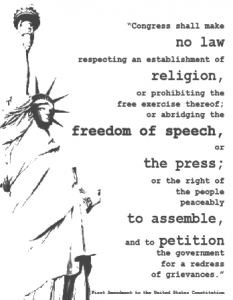What is Free Speech? Is it a prayer, picture, song, rap, poem, story, tweet, blog, flag, bumper-sticker, money, or video even one captured via smartphone? Is it what a politician says to followers, a preacher to those in the pews, a conversation at dinner, a lesson in a classroom, a made for TV movie? Is the message and method of delivery, analogous, or interdependent?
Is it saying whatever comes top of mind: What a bully, robber, abuser says to a victim. Or is it intentional speech? Is Parrhesia (truth-telling), as explored by French philosopher Michel Foucault, focusing on the truthteller rather than the content, important to the discourse on truth in the modern world?

In the beginning, our discourse was person to person, face to face or in a letter. The printing press modified speech making by both expanding the audience and creating powers inherent to those in control of the tools. Speech to more than one always came with controls: the ability to assemble people in a community with proximity or the filters of commitment, understanding or bias in the transporting of a message by word of mouth.
In the digital age, Free Speech is morphing once again, creating more challenging times for those of us committed to the ideals underpinning this freedom and the belief that the absence of speech to counter radical views is dangerous for all; that beyond a constitutional right speaking freely embodies the concept of speaking truthfully & boldly with both obligations and risks.
“once we give up on the right to offend in the name of ‘tolerance’ or ‘respect’, we constrain our ability to challenge those in power, and therefore to challenge injustice.” British author Kenan Malik argued in the wake of the Charlie Hebdo massacre
